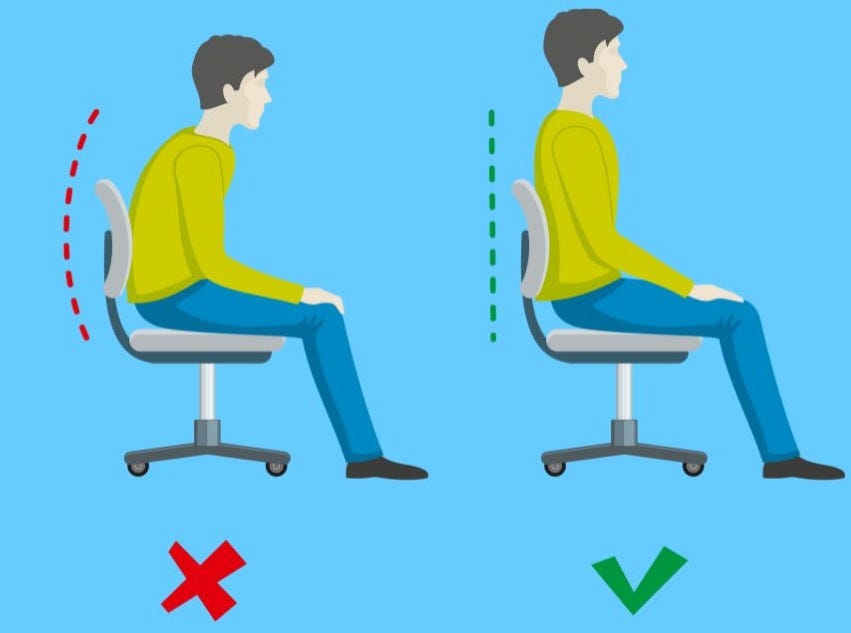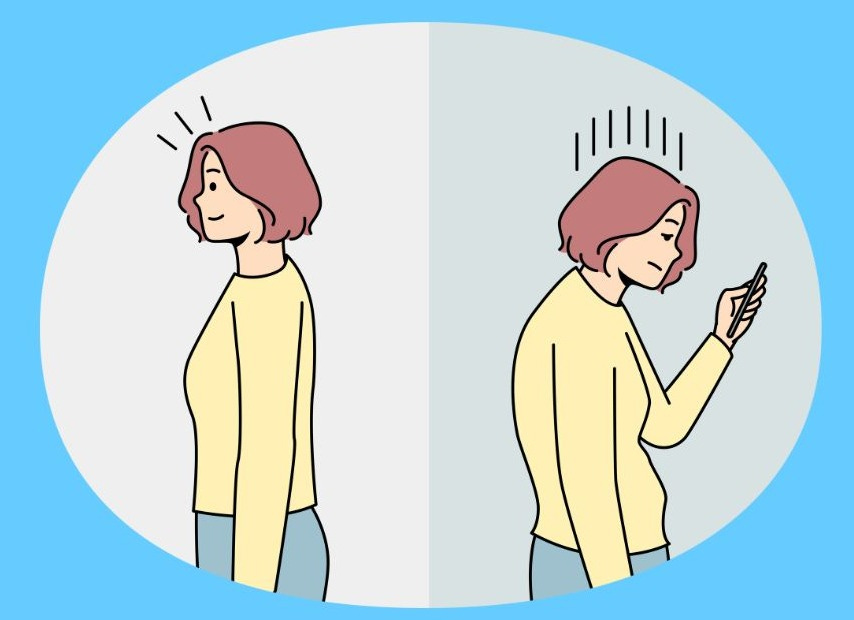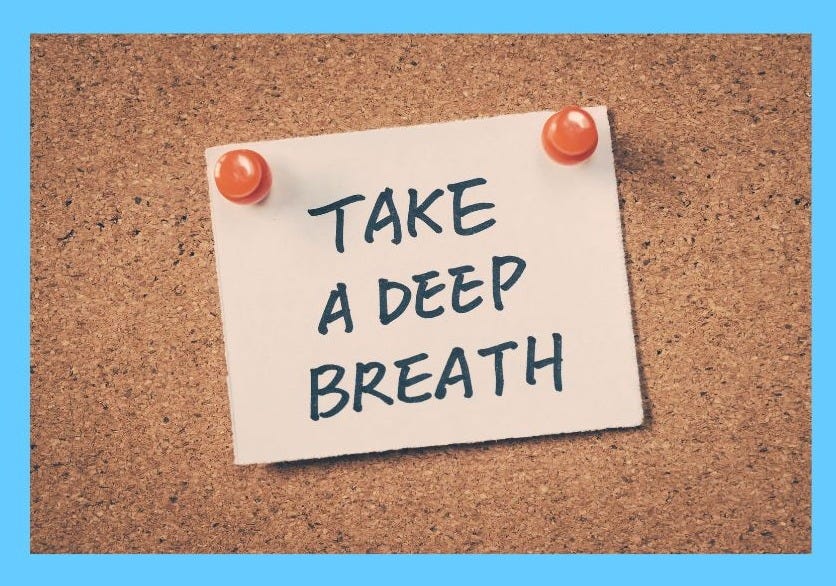Did you know that focusing on your breathing and improving the way you breathe can enhance your posture? It’s a symbiotic relationship—good posture improves your ability to breathe, and proper breathing enhances your posture.
The best part? Many find it easier to focus on breathing patterns than to constantly remind themselves to stand up straight. If your breathing feels restricted, it could signal that your posture needs attention.
The way you breathe affects your overall well-being, from your physical balance to brain function. For older adults—particularly women—proper breathing is an often-overlooked key to maintaining health, confidence, and mobility.
Try This Now: A Quick Breath-Posture Check
Sit in a chair with your upper back rounded and shoulders slumped. From this slouched position, let your shoulders roll slightly toward your chest. Now take the deepest breath you can. How did that feel?
Next, roll your shoulders and neck forward into a full slouching position. Then, slowly pull your head and shoulders up into a tall sitting position. Push your lower back forward and accentuate the curves of your spine. This will likely feel forced and uncomfortable, but hold for several seconds. Release this sitting position slightly, and you’ll be sitting in a good posture position. Scoot yourself back in the chair until your back is against the chair and your hips are in the bend of the chair. Straighten up. Now take the deepest breath you can. Did that feel any different?
The first breath probably felt constricted, while the second breath probably felt like your body got a good dose of air.
Why Women Need To Pay Extra Attention to Breathing and Posture
While proper breathing benefits everyone, women face unique challenges that make breathwork and posture awareness even more crucial:
Higher risk of osteoporosis: Bone density loss can lead to spinal compression, reducing lung capacity and making deep breathing more difficult.
Hormonal shifts: Menopause-related changes can weaken muscles, including the diaphragm, impacting breathing efficiency.
Smaller lung capacity: Women generally have smaller lungs than men, making proper breathing techniques essential for oxygen efficiency.
Core muscle changes: Pregnancy, childbirth, and hormonal fluctuations affect core and pelvic floor muscles, which play a role in posture and breathing mechanics.
Increased likelihood of forward head posture: Studies suggest that women, due to factors such as greater ligamentous laxity, caregiving roles, and prolonged screen time, may be more prone to forward head posture, which restricts airway openness and decreases breathing efficiency.
Understanding these factors reinforces why prioritizing breathing and posture is especially important for women as they age.
Breathing, Posture, and Brain Health Links
When we talk about posture, we’re addressing far more than just standing up straight. Poor posture can lead to:
Shallow breathing, which limits oxygen intake and energy levels.
Increased muscle tension, particularly in the neck and shoulders.
Compromised balance, making falls more likely.
Reduced lung capacity, affecting endurance and mobility.
Cognitive decline, due to insufficient oxygen reaching the brain.
Emerging research highlights that deep, intentional breathing increases oxygen supply to the brain, enhancing cognitive function and reducing brain fog. When posture is poor, airflow is restricted, which can contribute to mental fatigue and slower reaction times. Studies suggest that improving breathing efficiency can help sustain memory, focus, and overall brain health as we age.
The Aging Challenge: Why Breathing Becomes More Difficult Over Time
As we get older, several physiological changes can make breathing less efficient:
Weakened diaphragm and intercostal muscles, making deep breathing more challenging.
Spinal curvature changes, which can compress lung space.
Reduced lung elasticity, limiting oxygen intake capacity.
Stress-induced shallow breathing patterns, creating chronic muscle tension.
Decreased physical activity, reducing overall respiratory fitness.
The Goal: Strength, Stability, and Mental Clarity
Imagine moving through your fifties, sixties, seventies and beyond with better balance, increased energy, and mental clarity—all by breathing your way to better posture. Focusing on your breathing can lead to remarkable improvements:
Stronger core engagement, enhancing balance and stability, thereby reducing your fall risk and increasing your confidence.
Reduced muscle tension, particularly in the neck, shoulders, and upper back, allowing you to perform daily activities with greater ease.
Improved oxygen flow to the brain, enhancing cognitive function and mental focus.
Greater energy availability for daily activities and exercise.
Better stress management and emotional regulation.
This isn’t just a hopeful wish—it’s entirely possible with intentional breathwork and posture awareness.
How To Fix Common Posture and Breathing Pitfalls
1. Shallow Chest Breathing
The Issue: Many people develop a habit of breathing only into their chest rather than using their diaphragm, leading to tension in the neck and shoulders. This often occurs due to poor posture.
Diaphragmatic breathing—also known as abdominal or belly breathing—engages the diaphragm fully, promoting efficient oxygen exchange and reducing unnecessary muscle tension. This technique not only aids in relaxation but also strengthens the diaphragm, leading to improved posture and core stability.
Correction Strategies:
Diaphragmatic Breathing: Place one hand on your chest and one on your belly. Inhale deeply through your nose, allowing your belly to expand while keeping your chest still. Exhale slowly through pursed lips. Repeat for 5 minutes daily.
Postural Awareness: Sit tall with your shoulders relaxed, ensuring your ribcage has room to expand with each breath.
2. Forward Head Posture and Constricted Airways
The Issue: Slumping at a desk or looking down at a phone compresses the airways, making breathing less efficient.
Correction Strategies:
Chin Tucks: Gently pull your chin back as if making a double chin, aligning your head with your spine. Hold for 5 seconds and repeat 10 times.
Breath Alignment Check: Stand tall and take a deep breath. If you struggle to inhale fully, adjust your posture until your breath flows easily.
3. Holding Your Breath During Movement
The Issue: Many people unconsciously hold their breath while exercising or doing daily tasks, increasing muscle stiffness and decreasing stability.
Correction Strategies:
Breath-Movement Coordination: Exhale as you exert effort (e.g., lifting a bag or standing up from a chair) and inhale as you relax.
Rhythmic Breathing: During walking, try inhaling for three steps and exhaling for three steps to promote steady airflow and core engagement.
What If You Don't Address Your Breathing and Posture Now?
Ignoring posture and breathwork can have long-term consequences:
Increased risk of falls due to poor balance and reduced stability.
Chronic muscle tension and pain, particularly in the neck, shoulders, and lower back.
Reduced lung function, making daily activities more difficult.
Brain fog and cognitive decline from limited oxygen supply.
Decreased energy levels leading to more sedentary habits.
The good news? These outcomes are largely preventable with small, consistent changes.
Scientific Support for the Breath-Posture Connection
Research underscores the importance of breathing for overall well-being:
Breathing and Balance: A 2021 study published in Frontiers in Physiology found that deep diaphragmatic breathing enhances postural control and stability, reducing the risk of falls, particularly in those suffering with Parkinson's disease.
Another study published in PubMed indicated that promotion of a costal-diaphragmatic breathing pattern may be associated with improvement in balance. The research showed a decrease in balance errors as breathing scores improved, suggesting a direct link between breathing techniques and postural stability.
Oxygen and Brain Function: Research published in Medical News Today highlighted that controlled breathing influences attention in the brain. The study found that participants who focused better on cognitive tasks had better coupling between respiration patterns and attention. This suggests that regulating breathing can optimize attention levels and potentially improve overall brain function and reduce stress-related brain fog.
While these studies provide strong evidence for the benefits of proper breathing techniques on posture, brain health, and balance, it’s important to note that more research is needed to fully understand the mechanisms and extent of these effects. Nonetheless, the existing research strongly supports the incorporation of breathing exercises and mind-body practices into daily routines for improved overall health and well-being.
Your Posture and Breathing Plan
1. Daily Breath Awareness Check-In
Stand with your back against a wall, with heels, buttocks, shoulders, and head touching the wall.
Inhale deeply—does your belly expand, or does your chest rise first?
Adjust your posture until your breath feels full and effortless.
2. Strengthen Your Breathing Muscles
Wall Angels: Stand with your back against a wall, arms at your sides. Slowly raise your arms in a “snow angel” motion while keeping your lower back and shoulders in contact with the wall. Strengthens upper back muscles to prevent slouching and improve lung expansion.
Seated Core Engagement: Sit tall, place hands on thighs, and take a deep breath. As you exhale, gently pull your navel toward your spine while maintaining an upright posture. Builds core strength to support spinal alignment and deeper breathing.
Gentle Bridges: Lie on your back, knees bent, feet flat on the floor. Lift your hips, creating a straight line from knees to shoulders. Hold for 5 seconds, then lower. Improves lower back and core stability, reducing spinal compression for easier breathing.
3. Incorporate Various Breathing Exercises
Try different breathing techniques to enhance your breathing patterns:
4-7-8 Breathing: Inhale through the nose for a count of 4, hold the breath for 7 counts, and exhale through the mouth for 8 counts. This method can promote relaxation and mental clarity.
Box Breathing: Inhale for 4 counts, hold for 4 counts, exhale for 4 counts, and hold again for 4 counts. This technique helps in managing stress and enhancing focus.
4. Incorporate Breath-Focused Flexibility Exercises
Chest Opener: Stand in a doorway with your arms on either side of the frame at shoulder height. Gently lean forward until you feel a stretch across your chest. Hold for 30 seconds. This expands your ribcage for deeper, unrestricted breaths.
Neck Stretches: Slowly tilt your ear toward your shoulder until you feel a gentle stretch. Hold for 30 seconds on each side. This relieves tension that can restrict airflow.
Hip Flexor Release: Kneel on one knee with the other foot planted in front. Gently push your hips forward until you feel a stretch in the front of your hip. Hold for 30 seconds on each side. This stretch supports core engagement, making deep breathing easier.
Practical Tips For Daily Integration and Success
Transforming your breathing and posture requires consistency, not perfection. Here are simple ways to integrate better breathing into your everyday life:
Morning Routine Integrations
Mindful Morning Breath: Before getting out of bed, take 5 deep belly breaths while lying flat.
Shower Posture Check: Use shower time for a quick posture reset—stand tall and take 3 deep breaths.
Breakfast Breathing: Take one full, mindful breath before your first bite of food.
Workplace/Home Office Habits
Screen Break Breathing: Every 30 minutes, look away from screens and take 3 deep breaths.
Doorway Stretch: Each time you walk through a doorway, pause for a quick shoulder roll and deep breath.
Posture Support: Consider using a lumbar roll or posture cushion when sitting for extended periods.
Water Reminder: Take a deep breath before and after each sip of water throughout the day.
Visual Reminders: Place "BREATHE DEEPLY" sticky notes at key locations around your home or office.
Evening Wind-Down Rituals
TV Commercial Breathing: Use commercial breaks as reminders to check posture and take 3 deep breaths.
Pre-Bedtime Reset: Stand against a wall for 30 seconds with your head, shoulders, and hips touching the wall while breathing deeply.
Gratitude Breath: End each day with 3 deep breaths while mentally listing things you’re grateful for.
Breathe and Stand Tall
Better breathing isn’t just about taking in more air—it’s a comprehensive approach to enhancing posture, improving balance, and boosting overall wellbeing. If you’ve struggled to maintain good posture despite constant reminders, shifting your focus to your breath might be the transformative approach you’ve been missing.
Your body has supported you through decades of life. Now it’s time to return the favor by giving it the oxygen and alignment it deserves. The breathing techniques and posture exercises outlined here require minimal time investment but offer potentially life-changing benefits for your mobility, confidence, and quality of life.
What was your “aha moment” about how breathing and posture might be connected to problems you’ve been experiencing, and which technique from this article are you most excited to try first?
Here’s to breathing better, standing taller, and living your most vibrant life at any age!
Your 4-Week Posture and Breathing Improvement Plan
Week 1: Foundation Building
Daily Practice:
Morning posture wall check (2 minutes)
Diaphragmatic breathing practice (5 minutes, three times daily)
Hourly breathing reset alarm (30 seconds each hour)
Exercises:
Gentle shoulder rolls (10 repetitions, twice daily)
Basic chin tucks (10 repetitions, twice daily)
Seated breathing awareness (5 minutes daily)
Goal: Establish awareness of your current breathing patterns and postural habits.
Week 2: Strengthening Core Breathing Muscles
Daily Practice:
Continued diaphragmatic breathing (increasing to 7 minutes, three times daily)
Breath counting during walking (5-10 minutes daily)
Posture check at doorways (pause briefly at each doorway you pass through)
Exercises:
Wall angels (8-10 repetitions, twice daily)
Gentle bridges with breath coordination (8-10 repetitions daily)
Seated core activation with breathing (5 repetitions, hold each for 5 breaths)
Goal: Begin developing strength in the muscles that support proper breathing and posture.
Week 3: Integration Into Daily Life
Daily Practice:
Breath-movement coordination during household tasks
Breathing visualization before sleep (7-10 minutes)
Posture reset after every meal
Exercises:
Chest opener stretches (hold for 30 seconds, repeat 3 times daily)
Hip flexor releases (hold for 30 seconds each side, twice daily)
Standing balance practice with breath awareness (3 minutes daily)
Goal: Begin integrating proper breathing and posture awareness into everyday activities.
Week 4: Refinement and Habit Formation
Daily Practice:
Full-body breathing scan (10 minutes daily)
Breath awareness during conversations
Gratitude breathing practice (5 minutes daily)
Exercises:
Gentle spinal twists with coordinated breathing (5 each side, daily)
Standing postural alignment with balance challenge (5 minutes daily)
Progressive muscle relaxation with breath focus (10 minutes daily)
Goal: Solidify new breathing and posture habits to maintain improvements long-term.










Excellent article, well researched and very interesting. Thank you for your hard work. It shows in this piece.
Kudos